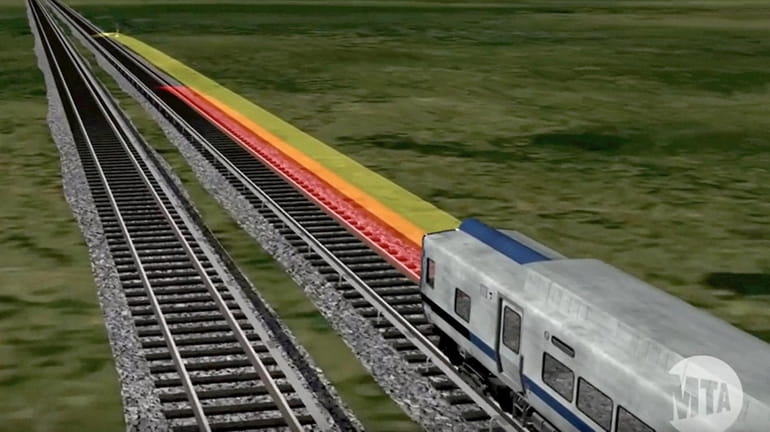MTA reps visit positive train control contractor in Pittsburgh

Positive Train Control technology uses antennas on trains and radio transponders on tracks to automatically slow down or stop a train that goes too fast or violates a signal. Credit: MTA/YouTube
Earlier this week, a group of MTA leaders, including the president of the Long Island Rail Road, toured the facilities where contractors are racing to complete the agency’s $1 billion federally mandated positive train control project.
On Monday, the delegation of Metropolitan Transportation Authority representatives traveled to Pittsburgh to visit the facilities operated by Bombardier Transportation and Siemens — the two firms hired in 2013 to develop the crash prevention technology, commonly referred to as PTC.
Among those on the six-hour tour were LIRR president Phillip Eng, Metro-North president Catherine Rinaldi, MTA managing director Veronique Hakim and several MTA board members, including Neal Zuckerman, who leads the board’s PTC working group.
“It was a very constructive set of conversations,” Zuckerman said Wednesday. “I would say that all of the people I spoke with, from the young men and women who were coding computers to the young men and women who were working on the shop floor at Siemens’ operation, seemed clear about their commitment to Metro-North and the Long Island Rail Road, clear about their mission, clear about their failures to date, and committed to solving them.”
The technology, to be installed throughout the LIRR and Metro-North, uses antennas on trains and radio transponders installed along tracks to automatically slow down or stop a train that goes too fast or violates a signal.
The unusual step of having MTA upper management travel to oversee a contractor’s work comes as the authority has demanded more accountability from Siemens and Bombardier, whose combined missteps have resulted in the PTC project falling behind schedule and going over budget.
Most recently, the contractor, while addressing a calibration error that resulted in the recall of about 1,000 "undercar scanner antennas" needed for PTC, realized it had made a mistake in how it was installing a related electrical component — soldering them onto circuit boards rather than bolting them, as specified by the manufacturer. The mistake required making additional repairs to the recalled antennas.
In May, the contractor assured MTA board chairman Patrick Foye that the project would be completed by the federal government’s December 2020 deadline.
Siemens and Bombardier officials have said they have taken measures to increase productivity and quality control.
In a joint statement, Siemens and Bombardier said the visit from MTA officials included “productive discussion, with frank and open questions and dialogue.”
“We look forward to continuing the collaborative and open dialogue as the project progresses,” the firms said. “We believe walking through the PTC project, roles and responsibilities, project timelines and manufacturing process was beneficial for all involved.”
Man who drove off North Fork cliff indicted ... Santos drops bid for Congress ... NTSB: 'No gas' in plane ... Knicks look ahead
Man who drove off North Fork cliff indicted ... Santos drops bid for Congress ... NTSB: 'No gas' in plane ... Knicks look ahead

